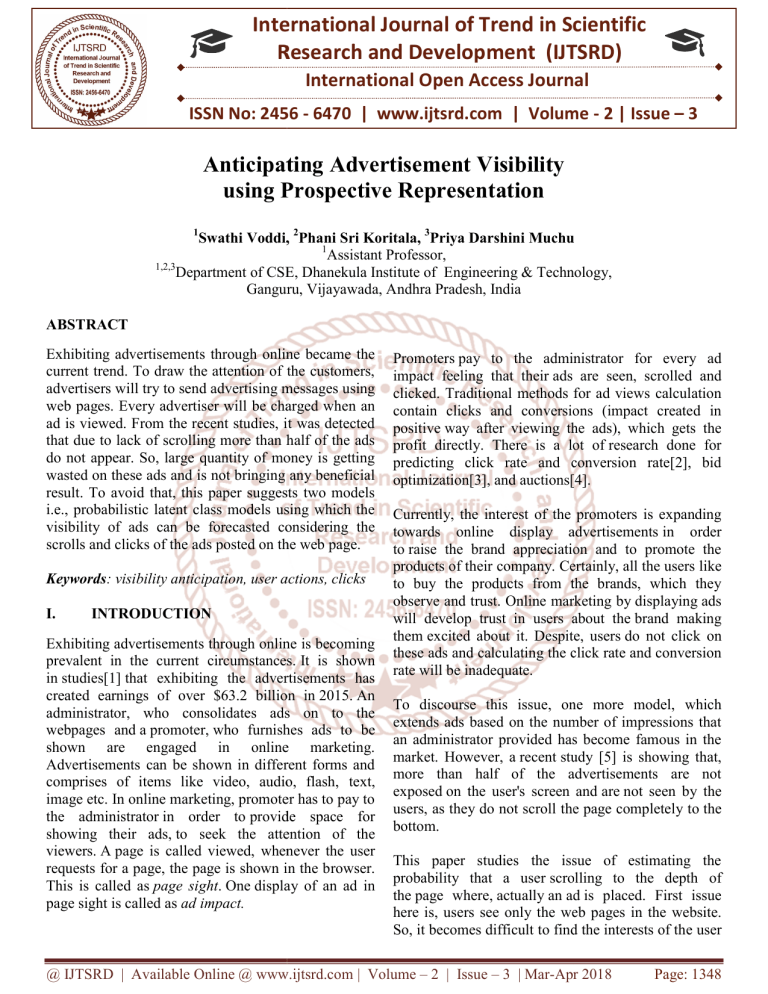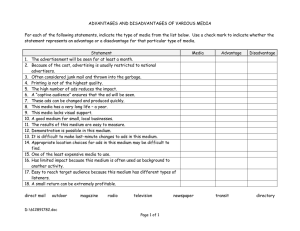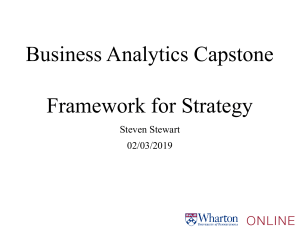
International Journal of Trend in Scientific Research and Development (IJTSRD) International Open Access Journal ISSN No: 2456 - 6470 | www.ijtsrd.com | Volume - 2 | Issue – 3 Anticipating Advertisement V Visibility using sing Prospective Representation 1 Swathi Voddi, 2Phani Sri Koritala, 3Priya Darshini Muchu 1 Assistant Professor, 1,2,3 Department of CSE, Dhanekula Institute of Engineering & Technology, Ganguru, Vijayawada, A Andhra Pradesh, India ABSTRACT Exhibiting advertisements through online became the current trend. To draw the attention of the customers, advertisers will try to send advertising tising messages using web pages. Every advertiser will be charged when an ad is viewed. From the recent studies, it was detected that due to lack of scrolling more than half of the ads do not appear. So, large quantity of money is getting wasted on these ads ds and is not bringing any beneficial result. To avoid that, this paper suggests two models i.e., probabilistic latent class models using which the visibility of ads can be forecasted considering the scrolls and clicks of the ads posted on the web page. Keywords:: visibility anticipation, user actions, clicks I. INTRODUCTION Exhibiting advertisements through online is becoming prevalent in the current circumstances. It is shown in studies[1] that exhibiting the advertisements has created earnings of over $63.2 billion in 2015. An administrator, who consolidates ads on to the webpages and a promoter, who furnishes ads to be shown are engaged in online marketing. Advertisements can be shown in different forms and comprises of items like video, audio, flash, text, image etc. In online marketing, promoter has to pay to the administrator in order to provide space for showing their ads, to seek the attention of the viewers. A page is called viewed, whenever the user requests for a page, the page is shown in the bbrowser. This is called as page sight. One display of an ad in page sight is called as ad impact. Promoters pay to the administrator for every ad impact feeling that their ads are seen, scrolled and clicked. Traditional methods for ad views calculation contain clicks and conversions (impact created in positive way after viewing the ads), which gets the profit directly. There is a lot of research done for predicting click rate and conversion rate[2], bid optimization[3], and auctions[4]. Currently, the interest of the promoters is expanding towards online display advertisements in order to raise the brand appreciation and to promote the products of their company. Certainly, all the users like to buy the products from the brands, which they observe and trust. rust. Online marketing by displaying ads will develop trust in users about the brand making them excited about it. Despite, users do not click on these ads and calculating the click rate and conversion rate will be inadequate. To discourse this issue, one on more model, which extends ads based on the number of impressions that an administrator provided has become famous in the market. However, a recent study [5] is showing that, more than half of the advertisements are not exposed on the user's screen and are not seen by the users, as they do not scroll the page completely to the bottom. This paper studies the issue of estimating the probability that a user scrolling to the depth of the page where, actually an ad is placed. First issue here is, users see only the web pages in the website. So, it becomes difficult to find the interests of the user @ IJTSRD | Available Online @ www.ijtsrd.com | Volume – 2 | Issue – 3 | Mar-Apr Apr 2018 Page: 1348 International Journal of Trend in Scientific Research and Development (IJTSRD) ISSN: 2456-6470 from the history. Second is, it is hard to find the important web pages and features of users. Here, topics in the page and interests of the user are the affecting aspects. However, a frequently used latent model, Singular Value Decomposition(SVD) is not sufficient to produce the probability estimation of scroll depth completely. There is another latent model, Support Vector Machine(SVM), which is an extension to the SVD and produces results in a more accurate way when compared to SVD. II. LITERATURE REVIEW After many researches, the scrolling behavior and visibility for web pages is examined. In [6], [7], [8], the authors recognized that upper half of the page is viewed more by users than the lower half of the page leading to wastage of time. Also, the division of the percentage of content seen by users is following distribution like Gaussian. In our main goal, which is visibility anticipation, we vary from these works. Existing work [9], [10] gathers scrolling behavior and uses it as an implicit indicator of user interests to measure webpage quality. In contrast we design algorithms to predict scrolling response for any user-webpage pair. In our application the existing methods for click anticipation are not applicable. Search engines are generally using Generalized Second Prize (GSP) auctions currently for vending their ad slots. When executing GSP auctions, most search engines had recommended approximate match between queries and bid keywords. Despite, it has been disclosed that there are many theoretical drawbacks in the GSP auction with standard broad match mechanism. III. PROPOSED SYSTEM In divergence to the existing system, in this paper we develop a web application where the key modules are user, admin and viewing/login. The basic functionalities of the admin is adding the advertisements into the website, viewing the ads, calculating the probability of the ads considering the views, scrolls, clicks and user behavior. The admin will be having the command to add, delete, and modify the ads, which are posted. Initially, former viewing the content in the application, every user should go through the phase of registration. Later, by logging in to the system, they can perform their actions in the website (where the ads will be displayed). Fig. 1 : Architecture of the system Any longer, to convene an ad as an efficiently scrolled or efficiently clicked one, it should attain the threshold point. Threshold point is the point, which describes the probability of an ad. SVM, which is the premier classifier, is used to get the accurate results. It possesses definite predictive ability in long run. Computing the mean and standard deviation can represent probability. The mean() and standard deviation() for each user will be calculated individually for their views, scrolls and clicks. Following the calculation for individual users, summation of those values will be used for determining the percentage of the visibility. Attribute Name Id Name Password Address Type Length Description Varchar 20 User’s id Varchar 20 User’s full name Varchar 20 User’s password Varchar 20 User’s address Table 1: User Registration Attribute Name AddID Type Length Description Varchar 20 ADD name Varchar 20 Add Index number Name of Ad Add Image BLOB 1MB Image Status Varchar 20 Active/Inactive Table 2: Adding ads Probability Calculation: PLC const outputs the probability P(xua|u, a), where xua is the max scroll depth that a user u reaches on a page a. Formally, PLC const works as follow: @ IJTSRD | Available Online @ www.ijtsrd.com | Volume – 2 | Issue – 3 | Mar-Apr 2018 Page: 1349 International Journal of Trend in Scientific Research and Development (IJTSRD) ISSN: 2456-6470 P(xua|u, a) = ΣNsΣNp P(s|u)P(p|a)P(xua|fuac, s, p; Wsp) where xua is the max scroll depth of a page view. Ns is the number of latent user classes, and Np is the number of latent webpage classes. l(P(s|u), P(p|a), W,σ) = Σu,a ln(ΣNsΣNp uac P(s|u)P(p|a)P(xua|f , s, p; Wsp) To maximize it, the Expectation Maximization (EM) Algorithm is assumed. The EM algorithm is widely used to solve the maximum-likelihood parameter estimation problem P(s|u)* ∝ Σ p,a P(s, p| fuac) P(p|a)* ∝ Σ s,u P(s, p| fuac) (α, β, W, σ) denote the weight vectors of all latent user and webpage classes as well as the weight vectors and standard deviations of all latent user and webpage class pairs, respectively. l(α, β, W, σ) = Σu,a ln(ΣNsΣNp P(s|fu ; αs) P(p|fa ; βp) P(xua|fuac, s, p; wsp)) Similar with PLC const, the EM algorithm is adopted to learn the parameters iteratively in PLC dyn. Ns/Np PLC_const PLC_dyn Ns = 1, Np = 1 0.4654 0.4501 Ns = 5, Np = 5 0.4501 0.4443 Ns = 6, Np = 8 0.4609 0.4425 Ns = 8, Np = 7 0.4581 0.4475 Ns = 10, Np = 10 0.4601 0.4467 promoters to enable them to spend more productively in promoting and can assist administrators to escalate their earnings. It consumes less memory and works fast when collated to comparative systems. REFERENCES 1. I. Lunden, “Internet ad spend to reach $121b in 2014,” http://techcrunch.com/2014/04/07/internetad-spend-to-reach121b-in-2014-23-of-537btotal-ad-spend-ad-tech-gives-display-a- boostover-search/. 2. Y. Chen and T. W. Yan, “Position-normalized click prediction in search advertising,” in KDD’12, 2012, pp. 795–803. 3. W. Zhang, S. Yuan, and J. Wang, “Optimal realtime bidding for display advertising,” in ACM SIGKDD’14, 2014, pp. 1077–1086. 4. W. Chen, D. He, T.-Y. Liu, T. Qin, Y. Tao, and L. Wang, “Generalized second price auction with probabilistic broad match,” in ACM EC’14, 2014, pp. 39–56. 5. "The importance of being seen", Nov. 2014, [online] Available: http://think.storage.googleapis.com/doc s/the-importance-of-being-seen_study.pdf. 6. S. Flosi, G. Fulgoni, A. Vollman, "If an advertisement runs online and no one sees it is it still an ad?", J. Advertising Res., vol. 52, 2013. 7. H. Weinreich, H. Obendorf, E. Herder, M. Mayer, "Not quite the average: An empirical study of Web use", ACM Trans. Web, vol. 2, no. 1, 2008. 8. F. Manjoo, "You won’t finish this article", Slate, 2013. 9. E. Agichtein, E. Brill, S. Dumais, "Improving Web search ranking by incorporating user behavior information", Proc. 29th Annu. Int. ACM SIGIR Conf. Res. Develop. Inf. Retrieval, pp. 19-26, 2006. 10. M. Holub, M. Bielikova, "Estimation of user interest in visited Web page", Proc. 19th Int. Conf. World Wide Web, pp. 1111-1112, 2010. IV. CONCLUSION To the best of our understanding, our paper recommends a proficient solution for anticipating the visibility prediction of ads taking in view the scrolls, number of clicks per user and webpage pair. Acquiring a solution to this issue can assist online 11. Chong Wang, Achir Kalra, Li Zhou, Cristian Borcea, Member,IEEE and Yi Chen, Member, IEEEs https://www.researchgate.net/publication/3170727 65_Probabilistic_Models_For_Ad_Viewability_Pr ediction_On_The_Web. @ IJTSRD | Available Online @ www.ijtsrd.com | Volume – 2 | Issue – 3 | Mar-Apr 2018 Page: 1350






